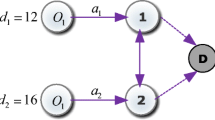Abstract
Evacuation planning in three-dimensional (3D) constrained space scenarios is an important kind of emergency management problems. In this paper, we investigate a path planning problem in constrained space evacuation for 3D scenarios, named the Priority-based Route Network Constructing Problem, which has two objectives of maximizing the evacuation exits’ utilization efficiency and minimizing the whole evacuation delay. We propose a 3-phase heuristic to construct a route network based on the Minimum Weighted Set Cover. In the experimental evaluation, we compare the proposed algorithm with the existing algorithms and implement our algorithm in underground mine evacuation, which is a typical kind of constrained space scenarios. Both types of results indicate our strategy can enhance the utilization efficiency of the escaping exits and guarantee a tolerable range of the global escaping time-consumption with a low running time.







Similar content being viewed by others
References
Özdamar, L., Demir, O.: A hierarchical clustering and routing procedure for large scale disaster relief logistics planning. Transp. Res. E: Logist. Transp. Rev. 48(3), 591–602 (2012)
Lahmar, M., Assavapokee, T., Ardekani, S.A.: A dynamic transportation planning support system for hurricane evacuation. Intell. Transp. Syst. Conf. 2006, 612–617 (2016)
Evans, J.: Optimization Algorithms for Networks and Graphs, 2nd edn. Marcel Dekker, New York (1992)
Cherkassky, B.V., Goldberg, A.V., Radzik, T.: Shortest paths algorithms: theory and experimental evaluation. Math. Program. 73(2), 129–174 (1996)
Jalali, S.E., Noroozi, M.: Determination of the optimal escape routes of underground mine networks in emergency cases. Saf. Sci. 47, 1077–1082 (2009)
Ernesto, Q., Vieira, M., Marta, M., Braz, P.: A New Algorithm for Ranking Loopless Paths. Technical Report, Univ. de Coimbra (1997)
Eppstein, D.: Finding the k shortest paths. SIAM J. Comput. 28(2), 652–73 (1998)
Jin, W., Chen, S.P., Jiang, H.: Finding the K shortest paths in a time-schedule network with constraints on arcs. Comput. Oper. Res. 40, 2975–2982 (2013)
Sever, D., Dellaert, N.P., van Woensel, T., de Kok, A.G.: Dynamic shortest path problems: hybrid routing policies considering network disruptions. Comput. Oper. Res. 40, 2852–2863 (2013)
Tanka, N.D.: A survey on models and algorithms for discrete evacuation planning network problems. J. Ind. Manag. Optim. 11(1), 265–289 (2015)
Choi, W., Hamacher, H.W., Tufekci, S.: Modeling of building evacuation problems by network flows with side constraints. Eur. J. Oper. Res. 35(1), 98–110 (1988)
Liu, Y., Chang, G.L., Liu, Y., Lai, X.R.: Corridor-based emergency evacuation system for Washington, DC: system development and case study. Transp. Res. Rec. J. Transp. Res. Board 2041, 58–67 (2008)
Vogiatzis, C, Walteros, J.L., Pardalos, P.M.: Evacuation through clustering techniques. In: Models, Algorithms, and Technologies for Network Analysis, pp. 185–198. Springer, New York (2013)
Lujak, M., Giordani, S.: Centrality measures for evacuation: finding agile evacuation routes. Future Gener. Comput. Syst. 83, 401–412 (2018)
Vogiatzis, C., Pardalos, P.M.: Evacuation Modeling and Betweenness Centrality. International Conference on Dynamics of Disasters. Springer, Cham (2016)
Goetz, M., Zipf, A.: Using crowdsourced geodata for agent-based indoor evacuation simulations. ISPRS Int. J. Geo-Inf. 1(2), 186–208 (2012)
Tang, F.Q., Ren, A.: GIS-based 3D evacuation simulation for indoor fire. Build. Environ. 49, 193–202 (2012)
Adjiski, V., Mirakovski, D., Despodov, Z., Mijalkovski, S.: Simulation and optimization of evacuation routes in case of fire in underground mines. J. Sustain. Min. 14(3), 133–143 (2015)
Garey, M.R., Johnson, D.: Strong NP-completeness results: motivation, examples, and implications. J. ACM 25, 499–508 (1978)
Acknowledgements
This research was supported in part by China National Scientific and Technical Support Program (2016YFC0801801), Beijing Natural Science Foundation (4174090), Program of Beijing Excellent Talents Training for Young Scholar (2016000020124G056). Prof. Wu and Prof. Xu were supported in part by China National Natural Science Foundation (41430318, 41272276, 41572222, 41602262), Beijing Natural Science Foundation (8162036) and State Key Laboratory of Coal Resources and Safe Mining.
Author information
Authors and Affiliations
Corresponding author
Additional information
Panos M. Pardalos.
Rights and permissions
About this article
Cite this article
Hong, Y., Li, D., Wu, Q. et al. Priority-Oriented Route Network Planning for Evacuation in Constrained Space Scenarios. J Optim Theory Appl 181, 279–297 (2019). https://doi.org/10.1007/s10957-018-1386-2
Received:
Accepted:
Published:
Issue Date:
DOI: https://doi.org/10.1007/s10957-018-1386-2
Keywords
- Path planning problem
- Constrained space evacuation
- 3D scenarios
- Route network
- Minimum weighted set cover




